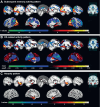Cognitive reserve against Alzheimer's pathology is linked to brain activity during memory formation
- PMID: 39537609
- PMCID: PMC11561234
- DOI: 10.1038/s41467-024-53360-9
Cognitive reserve against Alzheimer's pathology is linked to brain activity during memory formation
Abstract
The cognitive reserve (CR) hypothesis posits that individuals can differ in how their brain function is disrupted by pathology associated with aging and neurodegeneration. Here, we test this hypothesis in the continuum from cognitively normal to at-risk stages for Alzheimer's Disease (AD) to AD dementia using longitudinal data from 490 participants of the DELCODE multicentric observational study. Brain function is measured using task fMRI of visual memory encoding. Using a multivariate moderation analysis, we identify a CR-related activity pattern underlying successful memory encoding that moderates the detrimental effect of AD pathological load on cognitive performance. CR is mainly represented by a more pronounced expression of the task-active network encompassing deactivation of the default mode network (DMN) and activation of inferior temporal regions including the fusiform gyrus. We devise personalized fMRI-based CR scores that moderate the impact of AD pathology on cognitive performance and are positively associated with years of education. Furthermore, higher CR scores attenuate the effect of AD pathology on cognitive decline over time. Our findings primarily provide evidence for the maintenance of core cognitive circuits including the DMN as the neural basis of CR. Individual brain activity levels of these areas during memory encoding have prognostic value for future cognitive decline.
© 2024. The Author(s).
Conflict of interest statement
Figures






References
-
- Katzman, R. et al. Clinical, pathological, and neurochemical changes in dementia: a subgroup with preserved mental status and numerous neocortical plaques. Ann. Neurol.23, 138–144 (1988). - PubMed
-
- Arenaza-Urquijo, E. M. et al. Relationships between years of education and gray matter volume, metabolism and functional connectivity in healthy elders. Neuroimage83, 450–457 (2013). - PubMed
Publication types
MeSH terms
Grants and funding
LinkOut - more resources
Full Text Sources
Medical

